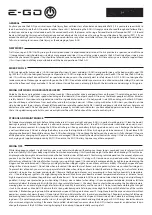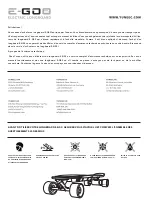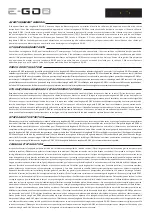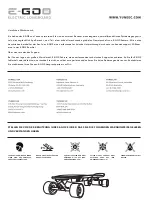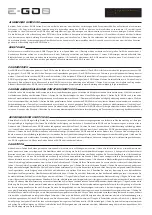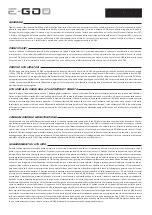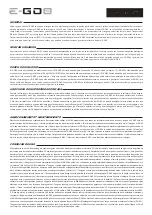
NEW RIDERS
RIDING OUTSIDE OF YOUR PRIVATE PROPERTY
GENERAL
RIDER PROFILE
STORAGE AND MAINTENANCE
Anytime you ride the E-GO, you risk serious or fatal injury from collisions, loss of control and unexpected falls // It is your sole responsibility to
learn how to safely ride the E-GO in order to reduce these risks // Before riding the E-GO it strongly advised to read through and follow all tips,
instructions and warnings listed underneath, this can reduce the risks that comes with using a Personal Electronic Transporter (PET) // It should
be clear that reading this manual will only reduce and not eliminate the risk inherent to using a Personal Electronic Transporter (PET) // If you
exceed the ability of yourself or your E-GO by riding over obstacles or any other unsuitable surfaces, this might potentially lead to collisions or
falls in turn leading to serious or fatal injury, or the damaging of your E-GO.
First time using an E-GO? start by riding in the low speed mode // Inexperienced riders are best to first practice in a spacious, non traffic zone
// Inexperienced riders should be assisted by a more experienced rider // Do not let new riders operate the E-GO outside of your supervision
unless they have read this guide // You should not allow anyone to step onto your E-GO for the first time unless you are there to support them
// Assist new riders until they are comfortable with the basic operation of the E-GO.
E-GO is designed for human riders // E-GO is designed for riders 14 years and older // E-GO is designed for riders with a body weight under 100
kg / 220 lbs // E-GO is not designed for cargo transportations // E-GO is designed for riders in good physical health // Do not ride the E-GO when
sick // As with any other Personal Electric Transportation device, you must be mentally alert to safely ride an E-GO // E-GO is not designed for
tandem use, do not take any passengers with you on the E-GO // Do not take a child in your arms or in a child carrier while riding // Do not ride
under the influence of drugs or alcohol // Do not attempt to ride if you can not comply fully with the instructions and warnings in this guide.
Abide by the laws and regulations in your state or country // Respect other drivers and pedestrians on the road // Avoid riding on busy roads
and crowded areas // Adjust your speed when riding on the sidewalk // Do not park your E-GO in a way that blocks people or traffic as it creates
a safety hazard // Cross roads at designated crosswalks or signaled intersections // Do not jaywalk / ride // When riding with other E-GO riders
you should keep a safe distance from each other and other transport devices // When riding with other E-GO riders you should not ride
side-by-side unless there is plenty of room left for pedestrians and other potential traffic // Identify and keep a safe distance from hazards and
obstacles on the road // Do not ride your E-GO on private property (inside or outside) unless you have obtained permission to do so // Be aware
that a strong electromagnetic field in your area might interfere with the function of the remote control system.
Do frequent maintenance checks: before riding make sure all screws are tight and your E-GO is in perfect working order // Clean the board's
bearings regularly // To clean the wheels it is advised to remove them from the axle // turn off E-GO and wireless controller when not in use //
Choose a cool environment for storing the E-GO and its charger // Keep your battery fully charged when not in use // Recharge the battery in
a well ventilated area // Do not recharge the battery in an area that might allow E-GO or its charging unit to become wet // Do not leave E-GO
charging unattended // Keep children away from E-GO when charging // Do not keep the battery on charge once it is fully charged // Stop use
of the product or charging unit if any wires are worn or damaged // Do not modify the electrical controls or wiring // Only use a motor, battery
or charging unit supplied or approved by E-GO // Do not use the E-GO's battery to power any other equipment.
While riding keep your back straight and use your arms to maintain balance // Bending your knees lowers your body's center of gravity which
increases stability // Shift your body weight to the front when accelerating // Shift your body weight to the back when braking // To turn / carve,
displace your body weight and exert pressure on the heel and toe sides of the board // Your turning radius depends on the amount of pressure
you exert on the side of the board: more pressure means sharper turning // Carving will slow down your speed and makes for an energy
efficient way of braking // Be mindful when turning / carving at high speed // You can adjust maneuverability by tightening or loosening the
kingpin nut (see online manual) // Adjust your riding style when riding at night or in conditions with low visibility // Adapt your speed to your
riding skill and environment // Do not ride when intoxicated // Beware that wet, frozen, oily or unpaved surfaces are unsuited for riding on //
To prevent loss of control, you must always pay carefull attention when riding and learn to identify and avoid slippery, icy, wet surfaces, loose
materials, steep inclines or slopes and obstacles // Beware that braking distances vary according to surface texture, humidity, temperature,
etc... // Avoid riding over gutters, this might damage the board // Make sure your board is at room temperature before use as extreme low or
high temperatures will reduce the performance of the batteries // Do not expose E-GO to water: do not ride when raining, do not ride through
puddles // Always wear protective gear when riding // Always wear a helmet when riding // Use an approved skateboard, bicycle or full face
motorcycle helmet that properly fits with the chin strap securely fastened // Use direct hand contact when operating the handheld remote,
wearing gloves or an unusual grip might interfere with your ability to accurately use the controls // Do not wear loose clothing that can get
stuck in the wheels or drive belt // Be aware that a strong electromagnetic field in your area might interfere with the function of the remote
controller // Brake when going downhill to moderate your speed // Taking on inclines over 10% might overheat the ecu and cause intermittent
power loss or even shut down the ecu // Do not ride E-GO down-hill more than 3% to avoid ecu overheating // Regular short burst of full power
and braking heavily will drain the battery faster than riding at a moderate consistent speed // Never ride on stairs, elevators or through revolv-
ing doors // Do not attempt jumps or other stunts, this might lead to injury or death and might damage your E-GO // Always be alert and aware
of your surroundings when riding // Be aware that so called 'wheel stops' can occur when the E-GO's wheels encounter an obstacle or terrain
change that prevents the E-GO from moving, bringing it to an abrupt stop, potentially causing a fall.
RIDING TIPS


